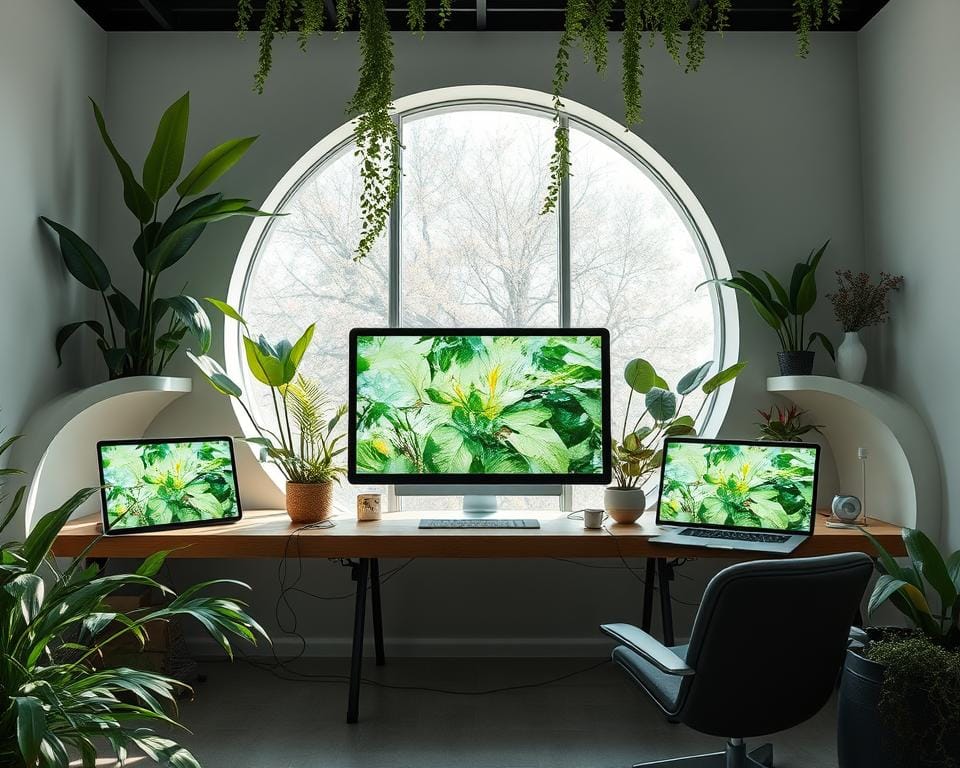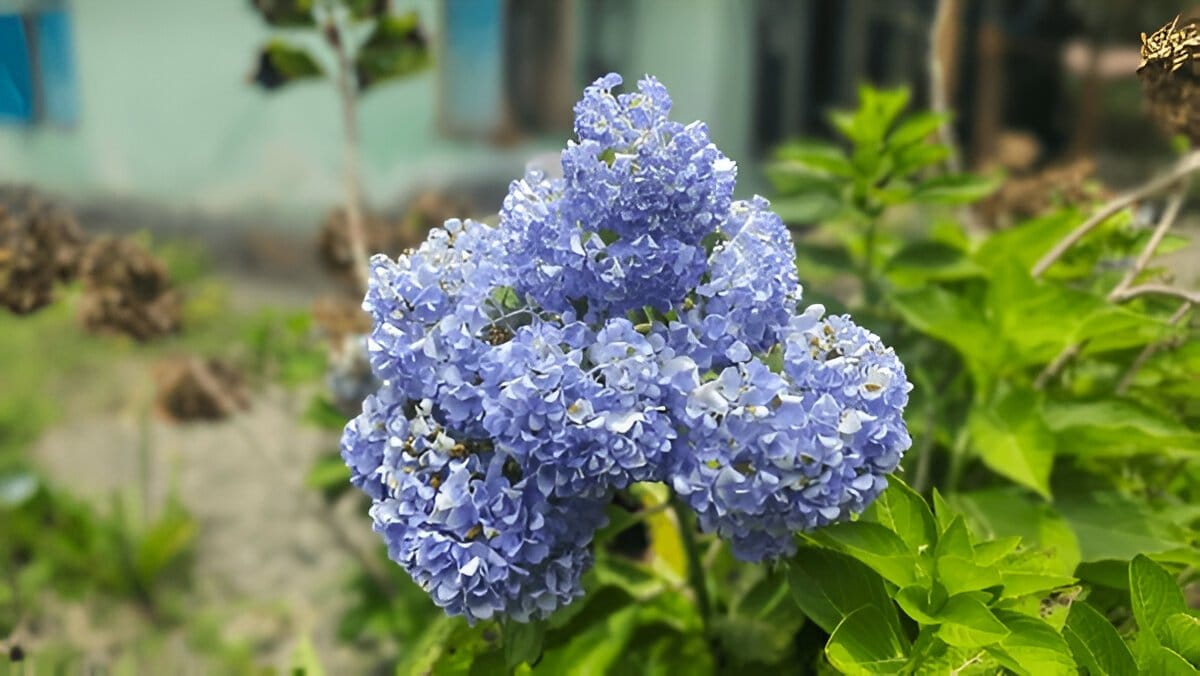

Welcome to exploring biophilic design in digital media for 2025. You’ll see how adding nature to digital spaces boosts user experience. This design focuses on looks and sustainability, linking users closer to their digital world.
There’s a growing love for digital sustainability. By using eco-friendly media, you can make users happier and more engaged.
This intro is your starting point. We’ll dive into ideas that blend digital creativity with nature. This creates a balance in our digital lives.
Understanding Biophilic Design in Digital Media
Biophilic design in digital media brings nature into our digital world. It makes our online experiences more engaging and emotionally rich. This idea is based on biophilia, our natural love for nature.
When we look at digital biophilic design, we see the use of organic shapes and natural colors. These elements bring the calm of nature into our digital spaces.
Many brands have made their websites feel like nature. They use green colors, smooth lines, and pictures of landscapes. This makes users feel calm and connected.
To use digital biophilic design well, think about texture and light. These elements make digital spaces feel more natural. This helps users feel better and more connected to what they’re seeing online.
The Importance of Nature in Digital Experiences
Adding natural elements to digital design has many benefits. Studies show that nature in design does more than just look good. It makes users feel better and enjoy their time online more.
When you use natural images and themes, people feel less stressed and more focused. They also seem happier with their online experiences.
Knowing how nature affects us helps improve digital experiences. Using nature’s appeal makes users feel more at home online. This makes brands stronger and more memorable to their audience.
Looking at case studies, we see that nature in design boosts user engagement. For example, companies with nature-inspired designs keep users longer and make them more loyal. This shows that using nature in digital design is key in today’s market.
| Company | Design Strategy | User Engagement Improvement |
|---|---|---|
| Nature’s Path | Natural imagery | +25% time on site |
| Patagonia | Organic shapes | +30% return visits |
| Airbnb | Color palettes inspired by nature | +20% booking rate |
10 Biophilic Design in Digital Media Ideas
Using biophilic design can make digital media better for users. Here are some ways to add nature to digital media. These ideas help make websites eco-friendly and connect with users through visuals.
Incorporate Natural Imagery
Photos, illustrations, and digital art that show nature can stir emotions and tell stories. Images of landscapes, forests, and water can make digital experiences more engaging. This method aligns with biophilic design, making users feel calm and connected.
Utilize Organic Shapes and Patterns
Using soft, flowing shapes that look like living things can make digital spaces feel welcoming. Shapes that remind us of nature, like leaves and flowers, can make interactions more enjoyable. This approach supports eco-friendly web design by creating a friendly atmosphere.
Emphasize Color Palettes Inspired by Nature
Colors are key in making digital spaces calm and interesting. Drawing from nature, you can create color schemes that feel calming and lively. Using earth tones, greens, and blues can reflect forests and oceans. This helps users feel more connected to their digital world.
Enhancing User Experience with Natural Elements
Adding natural elements to digital design makes it better for users. Nature-inspired UX strategies make the environment more engaging. Using sounds from nature, like a forest or river, can make users feel calm and connected.
Interactive elements that move like nature also boost the user experience. For instance, designs that sway or ripple can make the interface feel more alive. This makes users want to interact with it in a natural way.
Textures are also key. Using visuals that look like wood or stone can give users a sense of touch. This makes the digital product look and feel more real, creating a stronger connection.
Using these methods can make users stick around longer and feel happier. The calm and welcoming atmosphere they create keeps users engaged. This leads to more meaningful interactions and longer visits.
| Technique | Description | Benefits |
|---|---|---|
| Ambient Sounds | Integrating natural sounds to create an immersive environment. | Enhances relaxation and encourages longer visits. |
| Natural Movement | Design elements that mimic the flow of nature. | Increases intuitive interaction with the interface. |
| Textural Design | Utilizing visuals that replicate natural surfaces. | Creates a tactile experience, improving aesthetic appeal. |
Eco-Friendly Aesthetics in Web Design
Adding eco-friendly touches to web design shows you care about the planet. Choosing the right fonts is key. It makes your site look good and helps the environment.
Sustainable Typography Choices
What fonts you pick matters a lot. It affects how your site looks and its impact on the planet. Here are some good choices:
- Font Efficiency: Pick fonts that use less ink to cut down on waste.
- Web-Safe Fonts: Use fonts that load fast and don’t slow down your site.
- Minimalist Styles: Go for simple fonts to make your site load quicker and feel smoother.
- Custom and Accessible Fonts: Use special fonts made for easy reading and being green.
Using these tips makes your site look good and work better. It’s good for the planet and your visitors. This way, your site is not just pretty but also useful and green.
| Typography Choice | Environmental Impact | User Experience Benefit |
|---|---|---|
| Font Efficiency | Reduces ink usage | Lower printing costs |
| Web-Safe Fonts | Decreases server load | Faster load times |
| Minimalist Styles | Lowers carbon footprint | Enhanced readability |
| Custom and Accessible Fonts | Promotes inclusivity | Improved engagement |
Integrating Nature into Digital Interfaces

Adding nature to digital interfaces makes user experiences better. It creates a natural link between the digital and real worlds. This uses digital biophilic design applications to bring nature’s energy into our digital lives.
Using background videos of calm natural scenes can make users more engaged. They get pulled into these environments, leading to more interaction with the interface.
Think about adding interactive elements that remind us of nature. Things like moving leaves or water sounds make navigation easy and natural. This makes the site feel calm and easy to use.
New tech makes adding these features easy. There are many nature-inspired assets available. This helps designers create engaging sites without spending a lot. It also makes the site work better.
By following these ideas, you make your digital space more welcoming. People using biophilic interfaces feel more connected. This leads to better retention and happiness.
Trends in Biophilic Design for Digital Media
As digital media trends evolve, biophilic design becomes a key focus. It brings natural elements into digital experiences, making them more engaging. Technologies like augmented reality (AR) and virtual reality (VR) offer immersive experiences that feel like nature.
Brands at the forefront of biophilic design use new strategies. They use organic shapes, calming colors, and natural elements to create a peaceful feel. This not only grabs attention but also builds a strong bond between users and digital spaces.
Another trend is using dynamic interfaces that match nature’s flow. Digital media with animations that mimic nature’s movements improves the user experience. This way, you can make digital content that truly connects with your audience.
User-centered designs are becoming more common to create emotional connections. Companies are focusing on creating spaces that promote well-being. Adding nature-inspired elements makes digital spaces not just useful but also refreshing.
Exploring biophilic design trends in digital media can help you create meaningful interactions. These practices reflect nature’s calming presence in digital formats. Embracing these principles will make your designs stand out in a competitive field.
Case Studies of Successful Biophilic Designs

Looking at case studies in biophilic design shows us how to bring nature into digital campaigns. These examples show us how to engage users and the benefits of a nature-inspired approach.
Analyzing High-Impact Digital Campaigns
Many organizations have used biophilic design in their digital strategies. This has led to great results. Here are some campaigns that stand out:
- Nature Conservancy launched a campaign with immersive natural visuals. This boosted user interactions by 40%.
- Patagonia used earth-toned colors and organic designs. This led to a 25% increase in online sales.
- Airbnb showed eco-friendly listings with plant-filled images. This drew in more users who care about the environment.
Lessons Learned from Nature-Inspired Projects
These campaigns teach us important lessons for future projects:
- Using natural elements connects with people on an emotional level.
- Organic patterns and shapes make content more appealing.
- Brands that focus on sustainability attract eco-conscious consumers, building loyalty.
| Campaign | Brand | Key Feature | User Engagement Increase |
|---|---|---|---|
| Environmental Immersion | Nature Conservancy | Immersive visuals of natural habitats | 40% |
| Eco-Friendly Appeal | Patagonia | Earth-toned graphics | 25% |
| Sustainable Listings | Airbnb | Plant-filled imagery | 30% |
Learning from these case studies helps us see the power of biophilic design in digital spaces. It opens doors to new ideas for future campaigns.
Green UX Strategies for 2025
In 2025, making your digital projects more eco-friendly is key. People now want products that are good for the planet. By using eco-friendly design, you can make users happy and help the environment.
Creating websites that use less energy is important. Here are some ways to do it:
- Make images and files smaller to load faster and use less energy.
- Use designs that work well on all devices.
- Choose hosting that uses clean energy.
Helping users use less energy is also important. You can do this by:
- Creating a version of your site that uses less data for mobile users.
- Letting users choose darker themes to save energy on screens.
- Reminding users to use products for longer, like digital tools for more than one season.
Improving what you already have is also good for the planet. Look at how users interact with your site. Then, make changes that make it better and use less energy.
Using green UX strategies shows your brand cares about both users and the planet. It makes your brand look forward-thinking and in line with today’s values.
| Strategy | Description | Impact |
|---|---|---|
| Optimized Images | Reduce file sizes to enhance load times. | Lower energy consumption and improved user experience. |
| Responsive Design | Ensure functionality across devices. | Increased accessibility and reduced wasted resources. |
| Sustainable Hosting | Use servers powered by renewable energy. | Minimized carbon footprint and support for eco-friendly initiatives. |
Future of Sustainability in Digital Design
The future of digital design is all about being green. As tech gets better, designers can use new tools like AI to make things more eco-friendly. This means we can make designs that are better for the planet and use less resources.
Designers need to think about the planet when they work. They can do this in many ways, like:
- Using green tools and platforms.
- Designing things that use less energy.
- Following circular design, which means things can be reused and recycled.
As eco-friendly design becomes more popular, your role will grow. You can help make digital media more sustainable. By choosing to design in a green way, you make your work better and help the planet. It’s a chance to make a difference in the digital world.
| Aspect | Traditional Design | Sustainable Digital Practices |
|---|---|---|
| Resource Usage | High energy consumption | Efficient energy usage |
| Material Selection | Non-renewable resources | Renewable resources |
| Lifecycle | Linear model | Circular model |
By keeping up with these trends, you can help lead your projects towards a greener future. You’ll be making a big difference in the digital world.
Conclusion
The principles of biophilic design are key in digital media. They help make designs more engaging and emotionally rich. By adding nature-inspired elements, you can create a better user experience.
Using organic shapes and natural colors is a great start. These elements make designs more appealing and support sustainability in digital media.
Remember, biophilic design is more than making things look good. It connects users with their digital world, improving well-being and encouraging green practices. This trend is a movement you can join with your projects.
By adopting biophilic design, you help make digital experiences more natural. This approach not only sets your work apart but also meets users’ growing desire for meaningful online interactions. Begin using these principles today and lead in digital sustainability.
FAQ
What is biophilic design in digital media?
Biophilic design in digital media adds natural elements to digital spaces. It aims to make digital experiences more engaging and sustainable. This is done through visuals, interactions, and content that connect users with nature.
How can I implement sustainable design practices in my digital projects?
To make your digital projects sustainable, choose eco-friendly materials and tech. Optimize your website for energy use. Use sustainable typography and nature-inspired designs to improve user experience and reduce environmental impact.
What are some examples of nature-inspired digital creations?
Nature-inspired digital creations include websites with lush landscape videos. Apps use ambient nature sounds. UI designs feature organic shapes and earthy colors, offering a soothing experience.
Why is it important to incorporate nature in digital experiences?
Adding nature to digital experiences reduces stress and improves focus. It makes users feel more connected and engaged. This can lead to better retention and positive interactions.
What are some green UX strategies for more eco-friendly digital media?
Green UX strategies include optimizing website performance and designing minimalistic interfaces. Use eco-friendly hosting and encourage sustainable user behavior. This promotes digital well-being and resource conservation.
How can I enhance user experience with natural elements?
Enhance user experience by adding ambient nature sounds and designing interactive elements. Use textures inspired by nature and create an organic navigation flow. This fosters deeper engagement.
What are the latest trends in biophilic design for digital media?
The latest trends include using AR and VR for immersive nature experiences. There’s a focus on eco-friendly digital aesthetics. Brands are incorporating biophilic principles into their online branding and marketing.
Can you provide examples of successful biophilic designs in digital campaigns?
Successful biophilic designs integrate natural imagery and promote sustainability. They use nature-themed visual storytelling and interactive elements. These resonate with the audience.
What does the future hold for sustainability in digital design?
The future will see advancements in eco-friendly technologies like AI and machine learning. Designers will focus on sustainable choices, aiming to minimize digital carbon footprint.
RELATED POSTS
View all


